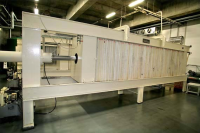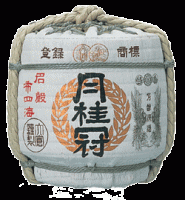
Brewing Process Overview
Rice is washed and steamed. This is then mixed with koji (a mold known technically as aspergillus oryzae). The whole mix is then allowed to ferment, and more rice, koji, and water is added in three batches over four days, as well as the yeast. This mash is allowed to sit from 18 to 32 days, after which it is pressed, filtered and blended. This would be enough to get you through most conversations. But let us look at the main steps and processes a bit more closely.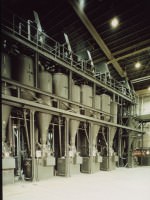
Rice Milling (Polishing)
There are particular varieties of rice used for making Sake. After proper sake rice has been secured, it is milled (or polished). This is not as simple as it might sound, since it must be done gently so as to not generate too much heat (which adversely affects water absorption) or not to crack the rice kernels (which is not good for the fermentation process). The amount of milling greatly influences the final product. The more polishing done on the rice, the better the quality of the Sake produced. The heart of the rice kernels is considered best for producing Sake. (This subject will be covered in a later discussion.)Washing and Soaking
Next, the white powder left on the rice after polishing is washed away. Following that, the rice is soaked to attain a certain water content deemed optimum for steaming that particular rice. The degree to which the rice has been milled in the previous step determines what its pre-steaming water content should be. The more a rice has been polished, the faster it absorbs water and the shorter the soaking time.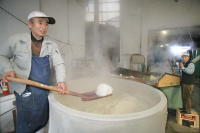
Steaming
Next the rice is steamed. This is different from the way table rice is prepared. It is not mixed with water and brought to a boil; rather, steam is brought up through the bottom of the steaming vat to work its way through the rice. This creates a firmer consistency, as well as a slightly harder outside surface and softer center. Generally, a batch of steamed rice is divided up, some having koji mold sprinkled over it, and some going directly to the fermentation vat.Koji Making
This is the heart of the entire brewing process, and could have several books written about it. Rice, unlike grapes, does not contain sugars. Without sugar, fermentation would not be possible. The koji mold contains an enzyme which breaks down the starch in the rice into sugars allowing fermenatation to take place.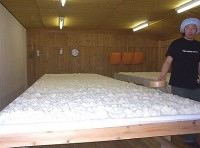
The Yeast Starter
A yeast starter, or seed mash of sorts, is first created. This is done by mixing finished koji and plain steamed white rice from the above two steps, water and a concentration of pure yeast cells. Over the next two weeks, a concentration of yeast cells that can reach 100 million cells in one teaspoon is developed.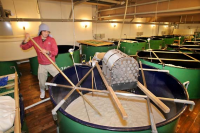
Fermentation
After being moved to a larger tank, more rice, more koji and more water are added in three successive stages over four days, roughly doubling the size of the batch each time. This is the main mash, and as it ferments over the next 18 to 32 days, its temperature and other factors are measured and adjusted to create precisely the flavor profile being sought.Pressing
When everything is just right, the sake is pressed. Through one of several methods, the white sediment and unfermented solids are pressed away, and the clear sake runs off. This is most often done by machine today. Older methods involved putting the mash in canvas bags and squeezing the fresh sake out, or letting the sake drip out of the bags.